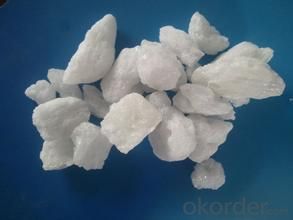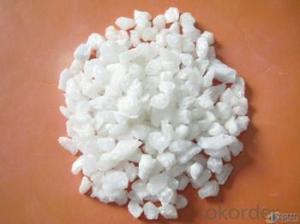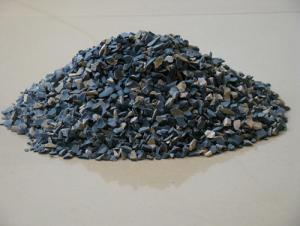white fused alumina for refractory 99.2% NA2O 0.3%
- Loading Port:
- China Main Port
- Payment Terms:
- TT OR LC
- Min Order Qty:
- -
- Supply Capability:
- -
OKorder Service Pledge
OKorder Financial Service
You Might Also Like
Packaging & Delivery
| Packaging Detail: | 25kg bag or ton bag or as your requirement. |
| Delivery Detail: | within 20 days delivery after receipt of advance payment. |
Specifications
99% high purity abrasive White fused alumina for refractory
1.White fused alumina99%
2.Refractory: 0-1mm, 1-3mm, 3-5mm, 5-8mm
Products discription
1.Introduction
The main raw material of white fused alumina is high grade processed alumina, which is fused with the carbon material and scrap iron in the electic furnace under the high temperature of above 2200°C.The product is characterized by low expansion coefficient, high refractoriness, good thermal and chemical stability.
2. Grain size commonly used
Refractory: 0-1mm, 1-3mm, 3-5mm, 5-8mm ,200#-0, 325#-0.
Abrasives: F24-F60.
Sandblasting abrasive:F10-F240.
Precision casting: F80-100, F100-F120.
Ceramic & electronic polishing:F240-800.
3.Physical properties of White Fused Alumina
Item | Color | Color System | Mohs Hardness | Melting Temperature(°C) | Refractory Temperature(°C) | True Density( g/cm3) | Magnetic Material |
Specification | white |
trigonal system | min10 | 2250°C | 1900°C | min3.50 | max0.003%
|
4.Chemical index of White Fused Alumina
Purpose | Specification | Chemical composition(%) | Magnetic material content(%) | ||||
Al2O3 | Na2O | SIO2 | CaO | ||||
For abrasive | F | 12#—80# | min99 | max0.6 | max0.4 | max0.003 | |
90#—150# | min98.5 | max0.003 | |||||
180#—240# | min98.2 | max0.7 | max0.4 | max0.002 | |||
For refractory | Size sand | 0—1mm | min99 | max0.5 | max0.4 | max0.003 | |
1—3mm | |||||||
3—5mm | |||||||
5—8mm | |||||||
Fine powder | 200#—0 | min98.5 | max0.5 | max0.5 | max0.003 | ||
325#—0 | |||||||
WE CAN ALSO DO NA2O:0.3% MAX IF CLIENT SPECIAL NEED.

- Q:How to distinguish the fire?rating of rubber and plastic thermal insulation material?
- Fire?rating grading of external wall thermal insulation materials. 1, China's national standard GB8624-97 divides the combustion performance of building materials external insulation materials into the following grade. Level A: Incombustible materials: Almost no burning materials. Level B1: Incombustible materials: Flame-like material has good fire-retardant effect. In case of fire in the air or at high temperature, it is difficult to fire and doesn't spread quickly, and when the fire source is removed after combustion, it stops immediately. Level B2: Incombustible materials: Combustible materials have a certain flame resistance. In case of fire in the air or at high temperature, it will immediately burst into flames, and easily leads to the spread of fire, such as poles, wooden frame, wooden beams and wooden stairs,ect. Level B3 : Incombustible materials: No flame-retardant effect, hidhly flammable and high fire risk. 2, The external wall thermal insulation materials could be divided according to the fire?rating. 1) thermal insulation material that has the level A combustion performance: Spraying inorganic fiber, glass wool, foam glass, ceramic foam, rock wool, foam cement and perlite obturator, and so on. 2), The thermal insulation material that has level B1 combustion performance: Special processed extruded polystyrene board (XPS) / special processed polyurethane (PU), phenolic and polystyrene powder. 3), Thermal insulation materials that have level B2 combustion performance: Molded polystyrene board (EPS), extruded polystyrene board (XPS), polyurethane (PU) and polyethylene (PE), etc. The information given is for reference only. Hope it will help you.
- Q:How to determine the fire resistance rating of the aluminium-plastic?panel?
- The fire resistance rating of the aluminium-plastic?panel is determined by two indicators, namely national compulsory standard of GB8624 "Building Materials Combustion Performance Grading Method ", and GB/T17748 "Aluminium-plastic?Composite Panel National Standard" . Classifications of combustion performance of building materials in our country are as follows: A class: Incombustible building materials; B1 class: Flame-retardant building materials; B2 class: combustible building material; B3 class: flammable building materials. The fire resistance rating of the aluminium-plastic composite panel shuld be no less than B1 class. 1. Detection indexes and requirements of fireproof aluminum-plastic composite panel (B1 class): (1) Conduct the test according to GB/T8625-88, the average leftover length of each test specimen should be more than 150mm, (any test piece should have leftover length), and the maximum average flue gas temperature of each test should be no more than 200 ℃; (2) Conduct the test according to GB/T8626-88, flame hight indicators.
- Q:Does anyone knows which company produces the better refractory materials?
- A:Building Materials Company of Guangzhou: Near the Baiyun District, Baiyun District, Guangzhou Road, North Road. B:Guangzhou Research & Development Co., ltd.: Liwan District Fengyuan road No.90 in Guangzhou City C: Huitailong decoration materials Co., Ltd.:the 30th floor of No. 111 Pacific Center, Taikang Road, Yuexiu District Guangzhou City D:Guangdong metal materials company: Near Qishan Road, Tianhe District , Guangzhou city.
- Q:which is better as household fireproof material ?
- If it is from the perspective of fire rating inorganic active insulation material for wall thermal, cement foam insulation board, glass beads of insulation movitrified?micro bead?thermal insulation?mortar, rock wool board, glass wool board, ect.. thermal insulation material are Class A fireproofing, polyphenyl board, extruded sheet, phenolic foam board, Polyurethane board, ect..belong to B1 level fireproofing, if it is used for external wall thermal insulation in decorative board, then rock wool board is more often used.
- Q:What do refractory materials include?
- It is so difficult.
- Q:What are the material requirements of class A fire resistant door ?
- Grade A fire resistance steel door, namely steel wooden doors or steel-wooden composite door, including reinforced wooden door, is usually used in indoor. In fact, it is the door with steel bar inside and density board or blockboard outside.
- Q:What are the standards of refractory concrete ?
- General requirements (1) All the materials for compounding refractory concrete must meet the design requirements and they should be checked according to the relevant standard. (2) The compounding of refractory concrete should be done strictly in accordance with the compounding proportion (usually weight), and the using of various binders, aggregates, coagulant, and water should be accurately measured. Tolerance of difference of cement, powder and water should be not more than 1 %; weight of aggregates does not exceed 3%. (3) The mix of different varieties of concrete must be prevented. (4) A variety of raw materials should be piled separately according to different species, mark numbers, dates of manufacture. Do not mix with limestone, silica, railroad ballast, dirt and other harmful debris.
- Q:what are the requirements of fireproofing material?
- answer: 1 fireproof materials are used in construction, in various forms and it has played an absolute role in modern fireproofing, common fireproofing materials include fireproof?panel, fire door, fireproofing glass, fire?retardant?coating, fireproof bag,etc. 2, fireproof?panel is the most common texture in the market. There are two common types: One is the high pressure decorating refractory slab, it's advantages are fireproofing,moisture-proof, wear-resistant, oil resistant, easy to clean, and it has various colors; another one is glass magnesium fireproof board, external layer is decoration materials, and inner layer is mineral magnesium fireproofing material, and it can endure 1500 degrees high temperature but has bad decoration. Installing fireproof suspended?ceiling in outlet channel of construction, stairwell and corridor can ensure safe evacuation of people and protect people from attacking of fire spreading in the disaster. 3, the production process of fire and moth proof wood: firstly, put general wooden materials into solution with calcium, aluminum and other cations, then soak it into solution with phosphate radical, silicate and other anions. Thus, the two ions will be carried out chemical reaction in the wood, forming a ceramic-like material, and intimately fill the voids of cells, so that the wood has the fireproofing and mothproof properties.
- Q:What defect does fused cast refractories have ?
- In glass production, in addition to refractory as a building material and consider its durability, we still must attach great importance to its influence on glass quality. In such cases, the impact on the quality of glass is mainly the defects that eroded down refractory materials mixed in the glass, thus being prodeced of grass products. Defects are mainly foreign body defects such as sand, knot and wave reinforcement. What may directly affect the quality of glass are the wall brick and brick kiln bottom.
- Q:Does refractory belong to metallurgical auxiliary materials?
- Refractory is widely used in industrial circle, such as metallurgy, chemical industry, petroleum, mechanical manufacturing, silicate and power, and its coonsumption is the maximum in metallurgy, accounting for 50% to 60% in total output. In order to improve slag-corrosion resistance of furnace lining, usually choose carbon-containing refractory. Refractory of various furnace lining are respectively: For the body, it is clay brick; as for the lower part, bosh and middle, it is SiC brick; for furnace bottom, it is carbon brick. Lattice brick is an important refractory product used in air heating furnace and regenerative chamber. Refractory is widely used in metallurgy. In order to improve slag-corrosion resistance of lining. Central line in tuyere and hearth are high-alumina brick. Refractory consumption is the maximum in metallurgy, accounting for 50% to 60% in total output. For the bosh and middle, it is SiC brick. In order to improve its thermal storage capacity: The furnace stack is clay brick. It is defined as refractory where the physical and chemical properties allows its use in high temperature environments; The lower furnace body
1. Manufacturer Overview |
|
|---|---|
| Location | |
| Year Established | |
| Annual Output Value | |
| Main Markets | |
| Company Certifications | |
2. Manufacturer Certificates |
|
|---|---|
| a) Certification Name | |
| Range | |
| Reference | |
| Validity Period | |
3. Manufacturer Capability |
|
|---|---|
| a)Trade Capacity | |
| Nearest Port | |
| Export Percentage | |
| No.of Employees in Trade Department | |
| Language Spoken: | |
| b)Factory Information | |
| Factory Size: | |
| No. of Production Lines | |
| Contract Manufacturing | |
| Product Price Range | |
Send your message to us
white fused alumina for refractory 99.2% NA2O 0.3%
- Loading Port:
- China Main Port
- Payment Terms:
- TT OR LC
- Min Order Qty:
- -
- Supply Capability:
- -
OKorder Service Pledge
OKorder Financial Service
Similar products
New products
Hot products
Related keywords































